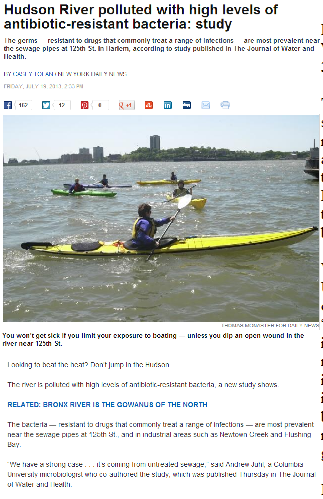 The Hudson River is an important watercourse serving as the gateway to mainland New York up north. Ships frequently pass through the river, allowing trade and tourism to reach inland, especially the state capital of Albany. As of late, however, the Hudson has been limited to shipping; Casey Tolan of the New York Daily News reports that its days of being a hot swimming spot are all but over.
The Hudson River is an important watercourse serving as the gateway to mainland New York up north. Ships frequently pass through the river, allowing trade and tourism to reach inland, especially the state capital of Albany. As of late, however, the Hudson has been limited to shipping; Casey Tolan of the New York Daily News reports that its days of being a hot swimming spot are all but over.
Water samples picked up and analyzed by Columbia University microbiologists detected significant traces of antibiotic-resistant bacteria, the so-called “superbugs.” These bacteria have developed strong immunity to antibiotics over time, rendering a number of those on the market ineffective. Swimming in the Hudson, especially with an open wound, increases the chances of getting the superbug. Experts believe methods such as proper storm water management could have prevented this problem from getting worse.
In fact, according to the state’s Department of Environmental Conservation (DEC), stormwater runoff is the leading cause of pollution in the Hudson River and its nearby tributaries. Green infrastructure along the river (around the Hudson Valley on a larger scope) is thus encouraged for homes, offices, and other facilities.
The DEC promotes even the simplest green infrastructural projects for homes and buildings around the Hudson Valley such as rain gardens, porous pavement, green roofs, and underground or above-ground rain barrels. The StormChamber system of Hydrologic Solutions, Inc. is an ideal stormwater management approach because it combines several measures, making it cost-efficient. It can retain and detain stormwater, as well as filter it via sedimentation for safe consumption.
While the state’s efforts since the Clean Water Act of 1972 to mitigate pollution in the Hudson has somewhat paid off-making it generally cleaner than before-officials advise the public to refrain from taking a dip in the river. Water activities along the river are limited to casual boating and kayaking (as long as you are wearing a wetsuit). Microbiologists found bacteria resistant to ampicillin and tetracycline in around ten locations along the Hudson.
Some of the most common stormwater best management practices (BMPs) can be implemented at a low cost. Urban areas should preserve what remains of the world’s freshwater to keep a steady amount of potable water in reserve for the generations to come. Without a doubt, the road to sustainability starts with investing in stormwater management measures.





